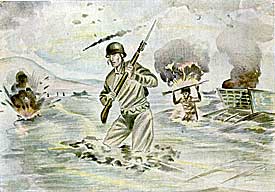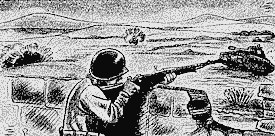|
|
|
|
II Bloody Salerno |
|
 At 0001 hours, September 9, 1943, the first of our
boat teams was called to station. Due to the presence of coastal guns, railway artillery
and mines, which blocked a close approach to the shores adjacent to the Gulf of Salerno,
it was necessary for the larger transports to anchor some twelve miles from the beaches.
The great historic significance of our efforts in being the first American troops to
invade the mainland of Europe was lost in the intensity of each living moment—the
blindness of coming into the darkness of the open decks from the lighted compartments
below; the bottomless insecurity of the landing craft suspended in mid-air from the
davits; the dryness in the throat that water would not take away; the incredible noise of
a transport shifting smaller craft and personnel into the air where they disappeared into
a darkness without walls or foundation; the lurching uneasiness of the boats idling in
column and then coughing and circling endlessly in the rendezvous area. At 0001 hours, September 9, 1943, the first of our
boat teams was called to station. Due to the presence of coastal guns, railway artillery
and mines, which blocked a close approach to the shores adjacent to the Gulf of Salerno,
it was necessary for the larger transports to anchor some twelve miles from the beaches.
The great historic significance of our efforts in being the first American troops to
invade the mainland of Europe was lost in the intensity of each living moment—the
blindness of coming into the darkness of the open decks from the lighted compartments
below; the bottomless insecurity of the landing craft suspended in mid-air from the
davits; the dryness in the throat that water would not take away; the incredible noise of
a transport shifting smaller craft and personnel into the air where they disappeared into
a darkness without walls or foundation; the lurching uneasiness of the boats idling in
column and then coughing and circling endlessly in the rendezvous area.As the craft formed into successive waves and started the pitching, endlessly rolling ride to the invisible shore, the backdrop of the entire sky to our left was illuminated by restless reflections of heavy gunfire where the British were laying down a preparation before landing. As we drew closer to the shore, we could see great fires burning in the Salerno area to the north. Since no preparation was to preceed our landing, all was silent to our front. "There is nothing as quiet as a battlefield before the battle." At 0330 hours, assault waves of our 1st and 3rd Battalions touched the beaches — beaches dominated in front and on the right by high hills from two to four miles inland. Our 1st Battalion was landed approximately 500 yards south of their designated Blue Beach. The first two waves of men proceeded inland, but as the third wave landed hostile guns engaged us from well prepared and strongly manned positions. Elements worked their way to the vicinity of a railroad bridge. The bulk of our men, however, was spread between the railroad bridge and the landing area when the enemy launched a vicious attack, supported by tanks, against the open left flank, of our 1st Battalion and the exposed right flank of our 3rd Battalion, driving a wedge between the two units and effectively preventing consolidation of the ground where our 1st Battalion had landed. The enemy turned his attack full to the south and cut deeply into our troops, engaged them with cross fire from guns in depth to our left, our front and to our right, rendering, for the time, any position on the edge of Blue Beach untenable. Enemy fire attained such an intensity that it was necessary to abandon further landing efforts on Blue Beach. Only three out of seven scheduled waves were able to land in this area. Subsequent waves, thoroughly disorganized, could not be controlled effectively in the water. Some coxswains moved to Yellow Beach to discharge their personnel; others simply milled about; some started to return to their ships. Fifth and subsequent waves met tank fire from the plain and from a battery of 88 mm. guns on Hill 78. Several boats were hit some distance from the shore, and our surviving personnel abandoned their equipment and attempted to swim to shore past others who floated in the water, dead or wounded. One craft, carrying elements of Company D, was sunk offshore and the men were picked up by an empty boat on its return trip. These men were re-equipped with submachine guns and landed later on Yellow Beach. Several craft, hit on the beach or near the shore, burned or drifted pilotlessly with their helpless cargo of dead and wounded. The terrain in our 1st Battalion's area was flat and cut by irrigation ditches bordered by bushes and a few small trees. Isolated patches of scrub growth were scattered throughout the area. Our men sought cover from the tank fire in the shallow ditches and concealment in the scrub growth. Attacking Germans fired down the ditches and swept the brush with fire from small arms and tanks. Three 75 mm. pack-howitzers, self-propelled, of our Cannon Company were slated to arrive in the third wave to support our 1st Battalion on Blue Beach. One craft, containing one of the guns, was turned back by the Navy, while another gun was disabled by a mine before clearing the beach, leaving only one gun to support our hard pressed troops. While the crew was directing this gun into a defile from which it could fire, they were engaged by enemy fire and the sight was destroyed. The platoon leader returned to the disabled gun on the beach, retrieved its sight and returned to his firing position. The gunner endeavored to place the sight in position, but was hit, by machine gun fire and instantly killed. The platoon leader, taking the gunner's position to adjust the sight, was seriously wounded before he could put the gun in operation.
Our 3rd Battalion, coming in to the left of our 1st Battalion, landed on Yellow Beach, which was about 30 yards deep. Farther inland, the landing area consisted of a dune covered with scrub-growth and followed by low, swampy, ground from 30 to 75 yards wide, running parallel to the shore line. Beyond this defile was a flat area, cut by a number of shallow irrigation ditches and one canal, and dotted with numerous patches of bushes and a few small trees. Many rock fences about four feet high paralleled the shore, and some formed narrow, channels in the line of advance, separating small farms and homesteads. The assault waves of our 3rd Battalion, proceeding in original boat team groups, completely overran the first defenses of Yellow Beach, despite enemy small arms, mortar, artillery and tank fire which was directed at all waves.. Because of the defender's violent reaction, the companies were unable to complete reorganization. Nevertheless, the battalions, advancing by infiltration, cleared the enemy fence by fence and house by house for a distance of about 400 yards before the Germans counterattacked our right flank. This enemy thrust, supported by tanks, was successfully broken up by elements of Company K, under the leadership of the operations officer, who was wounded in the leg and placed on the side of the canal after receiving medical attention. The tanks reformed and again pressed forward. The wounded officer, exposed to fire at the position where he lay helpless on the ground, continued to direct the defense of the flank until killed by the assaulting enemy. |
|
Copyright © 1945, 1998 141st Infantry Regiment
Association. |

 As morning brought light, the Germans launched another attack,
attempting complete destruction of our troops on Blue Beach. This attack was supported by
five Mark IV tanks which overran the area several times and withdrew inland only after our
men, sparked by the fury of desperation, counterattacked the armor individually and
without organization, employing hand grenades and rifles. The retreating tanks left behind
them a carnage of dead and wounded. The battalion had been completely neutralized as an
offensive force, although it still held tenaciously to its landing area. Overwhelmed by
superior fire, the men were prevented from reorganizing during the daylight hours of our
initial day.
As morning brought light, the Germans launched another attack,
attempting complete destruction of our troops on Blue Beach. This attack was supported by
five Mark IV tanks which overran the area several times and withdrew inland only after our
men, sparked by the fury of desperation, counterattacked the armor individually and
without organization, employing hand grenades and rifles. The retreating tanks left behind
them a carnage of dead and wounded. The battalion had been completely neutralized as an
offensive force, although it still held tenaciously to its landing area. Overwhelmed by
superior fire, the men were prevented from reorganizing during the daylight hours of our
initial day.